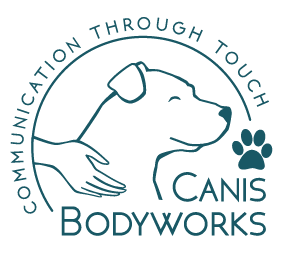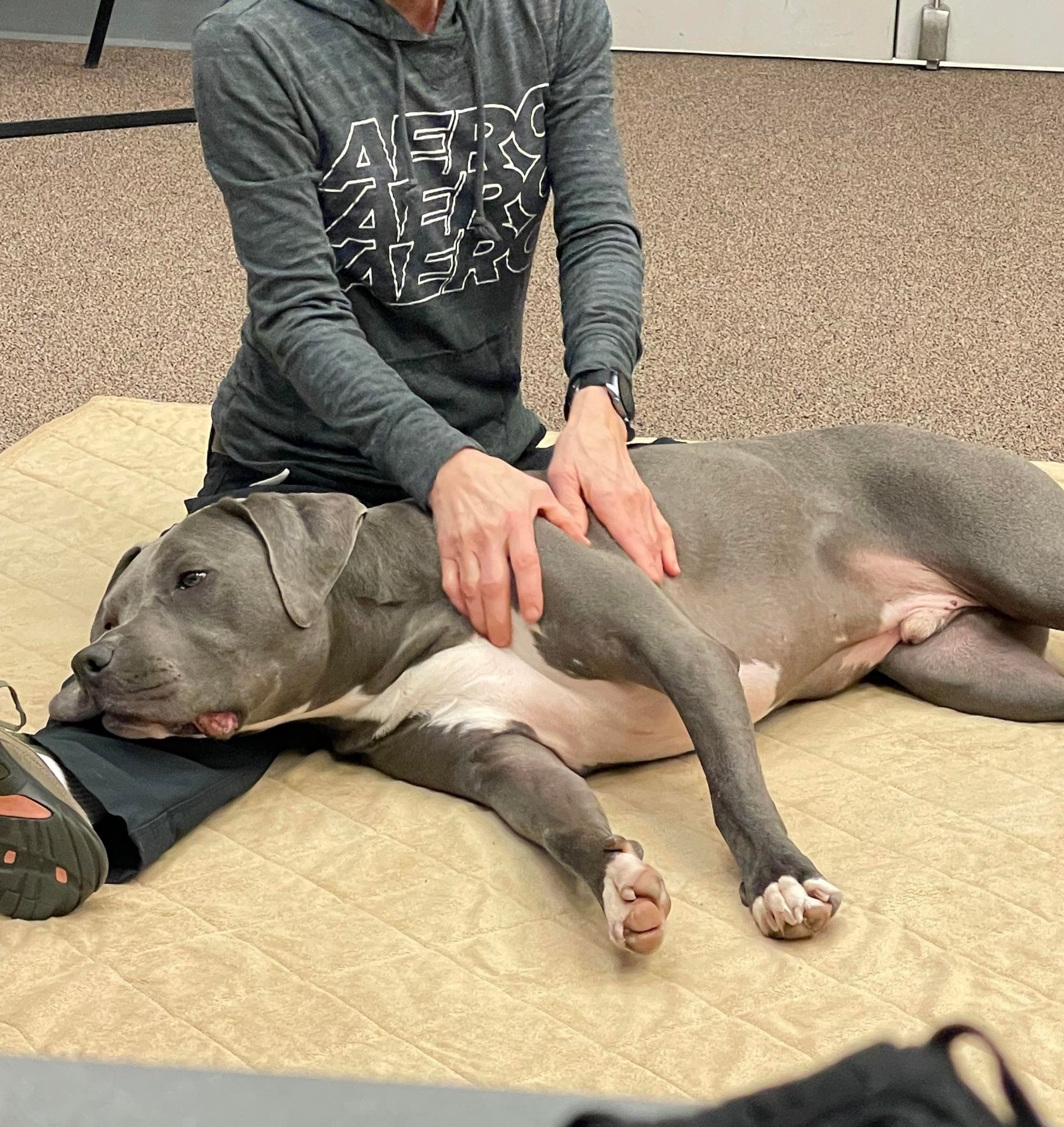“I massage my dog every day!” As canine massage therapists, we hear this sentiment frequently from
dog parents that we meet. However, chances are slim that the touch they’re providing their dogs is true
canine massage. By no means is that meant to diminish the value of a pet parent’s touch. Touch is
loving and instinctual, especially when it comes to our furry companions. Research has shown that
providing healthy, gentle touch to our pets is beneficial for the animal, as well as for the humans doing
the touching. True massage, though, involves more than touch.
If you’ve ever received a therapeutic massage from a professional massage therapist or physical therapist, you know how valuable it can be for reducing anxiety, stress, sore muscles, achy joints, and even pain. Dogs enjoy these and other benefits from therapeutic massage, but canine massage is quite different from massage for humans. In fact, there is much more to canine massage than people think.
Connecting with a dog through massage begins well before we ever lay our hands on the dog’s body. Even with our own dogs, we must first get permission to touch them, and sometimes that means building their trust. Trust-building requires skill and the ability to recognize what the dog is communicating to us. Learning and understanding canine body language is the cornerstone of effective, safe canine massage. Because there are so many subtleties and nuances involved in how a dog communicates, it’s important (and respectful) to learn their language so that we know when it’s ok to touch, as well as when it’s not.
In addition to trust-building skills, canine massage requires good palpation skills. When we feel a dog’s body – their fur, skin, muscles, and bones – we’re using our “thinking fingers” to gather information. Are we feeling an area that is warmer or cooler than other areas? Are there any new lumps or bumps that weren’t felt before? Does a muscle group feel particularly tight and hard, or loose and mushy? The more we palpate and touch our dogs with purpose, the more we become familiar with their bodies and what is “normal” for each individual. Think of palpation as the body telling us what it needs. Once our “thinking fingers” have gathered information about the dog’s body, we can plan our massage to address those findings.
How we massage, though, depends on a number of important factors, including knowing the most appropriate time of day, location, frequency, and length of time to work on each dog. It’s also particularly important to understand how to apply massage techniques correctly based on what each part of the body needs. It helps to have a basic knowledge of canine anatomy, as well as an understanding of areas of sensitivity. And, being able to recognize discomfort and pain is vital so that we can promptly refer the dog to a veterinary professional.
There is so much more to canine massage than rubbing or stroking a dog’s body, but it’s not rocket science. Anyone can learn the skills required to safely provide their dog with an effective massage that feels great and benefits the body and mind. One of our goals at Canis Bodyworks has always been to bring this amazing work to a wider audience. With our newest online course, Canine Massage for Pet Parents, we’ve distilled some of the essential knowledge and skills of canine massage into an easily digestible experience to help empower pet parents to provide their own dogs with true canine massage. With this course, they can accurately say, “I massage my dog every day.”
If you’ve ever received a therapeutic massage from a professional massage therapist or physical therapist, you know how valuable it can be for reducing anxiety, stress, sore muscles, achy joints, and even pain. Dogs enjoy these and other benefits from therapeutic massage, but canine massage is quite different from massage for humans. In fact, there is much more to canine massage than people think.
Connecting with a dog through massage begins well before we ever lay our hands on the dog’s body. Even with our own dogs, we must first get permission to touch them, and sometimes that means building their trust. Trust-building requires skill and the ability to recognize what the dog is communicating to us. Learning and understanding canine body language is the cornerstone of effective, safe canine massage. Because there are so many subtleties and nuances involved in how a dog communicates, it’s important (and respectful) to learn their language so that we know when it’s ok to touch, as well as when it’s not.
In addition to trust-building skills, canine massage requires good palpation skills. When we feel a dog’s body – their fur, skin, muscles, and bones – we’re using our “thinking fingers” to gather information. Are we feeling an area that is warmer or cooler than other areas? Are there any new lumps or bumps that weren’t felt before? Does a muscle group feel particularly tight and hard, or loose and mushy? The more we palpate and touch our dogs with purpose, the more we become familiar with their bodies and what is “normal” for each individual. Think of palpation as the body telling us what it needs. Once our “thinking fingers” have gathered information about the dog’s body, we can plan our massage to address those findings.
How we massage, though, depends on a number of important factors, including knowing the most appropriate time of day, location, frequency, and length of time to work on each dog. It’s also particularly important to understand how to apply massage techniques correctly based on what each part of the body needs. It helps to have a basic knowledge of canine anatomy, as well as an understanding of areas of sensitivity. And, being able to recognize discomfort and pain is vital so that we can promptly refer the dog to a veterinary professional.
There is so much more to canine massage than rubbing or stroking a dog’s body, but it’s not rocket science. Anyone can learn the skills required to safely provide their dog with an effective massage that feels great and benefits the body and mind. One of our goals at Canis Bodyworks has always been to bring this amazing work to a wider audience. With our newest online course, Canine Massage for Pet Parents, we’ve distilled some of the essential knowledge and skills of canine massage into an easily digestible experience to help empower pet parents to provide their own dogs with true canine massage. With this course, they can accurately say, “I massage my dog every day.”



